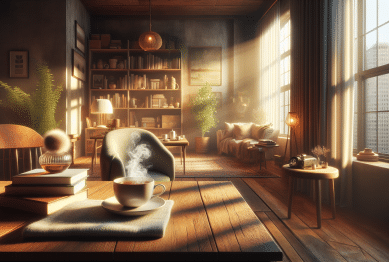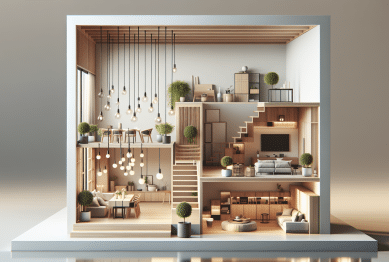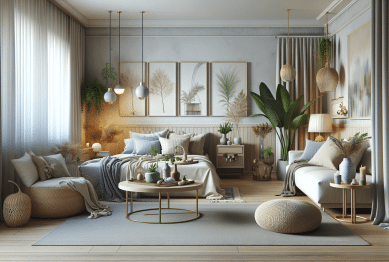Curious about why so many people are choosing minimalist living? This guide explores how embracing minimalism and sustainable home habits can impact your well-being, highlight essential decluttering strategies, and reveal surprising benefits of intentional consumption found in real homes.
Understanding the Minimalist Living Movement
Minimalist living is gaining visibility as more households look for ways to simplify their everyday routines and reduce stress. At its core, this lifestyle is about intentionally choosing what truly matters—shedding clutter, focusing on meaningful experiences, and eliminating excess possessions that bring neither joy nor value. Many find that a minimalist approach creates space for well-being and self-reflection. Living with less often means enjoying more room for creativity and deeper connections. By prioritizing quality over quantity, advocates of the minimalist lifestyle discover a new sense of freedom and clarity at home.
The origins of minimalist living can be traced to both Eastern philosophy and Western design traditions. Influences from Japanese Zen aesthetics and Scandinavian simplicity have merged into a global style that values open space, functional furniture, and natural light. While minimalism is often associated with modern home decor, its reach extends well beyond visual trends. Many individuals now use minimalist living principles to structure their daily schedules, budgets, and digital spaces. In an era of constant consumption, these practices can help reduce decision fatigue and foster mindful habits—making life feel less chaotic and more purposeful.
Adopting minimalist living doesn’t require radical change overnight. Some start small by reorganizing a single drawer or reevaluating monthly shopping habits. Others find inspiration from personal finance influencers, who recommend tracking spending to understand where money flows and value accumulates. Minimalism also intersects with environmental sustainability: fewer purchases result in less waste, and intentional consumption helps conserve natural resources. This shift in mindset can unlock unexpected emotional and financial benefits, giving people space to breathe, focus, and pursue personal growth. Minimalist living continues to attract new followers, hinting at society’s ongoing quest for simplicity.
Decluttering: The First Step Toward Simplicity
Decluttering stands at the very heart of the minimalist movement. It’s about more than simply tidying up—decluttering invites reflection on why belongings accumulate and whether they align with personal goals. Many who adopt minimalist living report feeling less overwhelmed and more energized after clearing away unused items. Popular decluttering methods, like the KonMari technique, recommend sorting possessions by category and keeping only those things that ‘spark joy.’ This method, now widely embraced, fosters a deeper relationship with the objects in our homes and offers an approachable entry point into a sustainable lifestyle.
The benefits of decluttering go beyond aesthetics. Studies cited by the National Institutes of Health have linked organized spaces to reduced anxiety and enhanced mental health (https://www.ncbi.nlm.nih.gov/pmc/articles/PMC5579406/). Fewer distractions can improve concentration, support productive routines, and make rest more restorative. Many individuals find that minimalist home layouts also promote physical wellness by providing more room to stretch, exercise, or enjoy hobbies. The act of letting go—be it of clothing, old gadgets, or sentimental clutter—can be surprisingly empowering.
Effective decluttering often requires developing a system for organizing personal items and designating regular times for review. Sustainable practices include responsibly donating items, recycling electronics, or joining community swaps to avoid unnecessary landfill waste. For many, the process is ongoing; seasonal decluttering or annual home audits keep clutter manageable. These rituals can become opportunities to reconnect with your evolving priorities. Over time, decluttering transforms from a task to a habit, helping households stay aligned with their minimalist living goals.
Sustainable Habits and Mindful Consumption
Minimalist living is closely tied to sustainability and mindful consumption—two values increasingly embraced in homes worldwide. By intentionally choosing how and what to consume, individuals can reduce environmental impact while supporting mental well-being. Shopping less and opting for high-quality, durable items supports both household harmony and planetary health. Research from the Environmental Protection Agency highlights the significant reduction in waste when families choose products designed for longevity rather than disposability (https://www.epa.gov/recycle).
Building sustainable home habits typically starts with small changes: using reusable containers, adopting energy-efficient lighting, or planning meals to avoid food waste. Minimalist living naturally encourages these habits by helping people evaluate the true usefulness and life-cycle of every item they bring in. Choosing local or second-hand goods further supports sustainability while often saving money. Over time, many discover new satisfaction in focusing on experiences or learning new skills instead of accumulating more material possessions.
Mindful consumption isn’t about deprivation—it’s about making conscious, values-driven decisions. This approach can extend to digital spaces, where minimizing screen time and managing online subscriptions helps reduce stress and free up time for meaningful connections. Minimalist households often explore community resources like lending libraries or tool shares to further reduce unnecessary purchases. By adopting these mindful and sustainable habits, many people unlock rewards: less clutter, greater peace, and positive impact on the world around them.
Designing Your Space for Minimalist Living
Design is key in bringing minimalist living to life. Adaptable layouts, neutral color palettes, and natural light can transform even small apartments into welcoming sanctuaries. Many designers recommend multifaceted furniture—think fold-away tables, modular shelving, or sofas with hidden storage—as ways to combine style and function. Simplicity doesn’t mean sterile; incorporating plants, warm textures, or curated art creates a harmonious ambiance. With the right choices, every corner of the home supports relaxation, focus, and creativity.
Clever storage solutions increase the efficiency of minimalist households. Built-in cabinetry, vertical shelving, and under-bed drawers keep surfaces clear and reduce visual clutter. Organizing experts like those at The Spruce recommend a ‘one in, one out’ rule: whenever a new item is purchased, another leaves the home (https://www.thespruce.com/tips-for-maintaining-a-decluttered-home-6380002). This simple principle ensures homes remain tidy and balanced despite occasional splurges. For renters or city dwellers, portable dividers and adaptable storage can make a big difference, allowing rooms to serve multiple purposes with minimal chaos.
The minimalist approach is also about customizing your living environment to meet your unique needs. Rather than imitating any single look, it encourages experimentation and flexibility. Some may seek inspiration from Scandinavian or Japanese interiors; others blend modern minimalism with personal touches such as handcrafted décor or heirlooms. The ultimate goal is to create a space that fuels well-being, showcases intentional choices, and reflects what matters most to the people who call it home.
Emotional Benefits of Living With Less
The emotional impact of minimalist living is often underestimated. Many who adopt the lifestyle report feeling calmer, more confident, and more resilient to outside stressors. In a world saturated with notifications and endless to-do lists, simplifying the home and calendar can be a grounding, restorative practice. Minimalism allows for reflection, which can help clarify long-term goals and foster gratitude for what’s already present.
Research from Susan Kaiser Greenland at UCLA’s Mindful Awareness Research Center points out that intentional changes in environment—like decluttering—are linked with improved mood and decreased anxiety (https://www.uclahealth.org/providers/susan-kaiser-greenland). Letting go of excess possessions helps reduce attachment to material goods and strengthens appreciation for relationships and health. Minimalist living is not about starkness; it’s about making room for passions, wellness, and deeper connections with loved ones.
For many, minimalist living becomes a lifelong journey. As priorities shift, so do the contents of closets, kitchen cabinets, and digital wallets. Those who stay committed to the process often find that setbacks and sentimental struggles subside, replaced by joy and ease. With fewer distractions and less clutter, energy can be spent more intentionally—on hobbies, friends, volunteering, or simply resting. In the end, the true reward of minimalist living is a greater sense of peace and freedom.
Creating Lasting Minimalist Habits
Sustaining minimalist living requires regular reflection and a willingness to adapt. Many find success by setting clear priorities, tracking new purchases, and revisiting decluttering routines seasonally. Journaling can reveal patterns in spending and help clarify which possessions or habits are genuinely meaningful. Community support—whether online or local—offers accountability and fresh ideas for sticking with the journey even when motivation dips.
Habit stacking is a practical strategy recommended by behavioral researchers like James Clear (https://jamesclear.com/habit-stacking). Pairing minimalist practices with existing habits—like reviewing a closet during laundry day—makes change easier. Digital minimalism, such as unsubscribing from email lists while enjoying morning coffee, helps ensure online spaces remain as uncluttered as physical ones. Over time, these routines become second nature, reinforcing the minimalist mindset well beyond the home.
Those who embrace minimalist living don’t follow a rigid rulebook. Instead, the lifestyle provides a flexible foundation for shaping a purposeful life—one in which happiness is defined by experiences rather than objects. As new challenges arise or life circumstances shift, minimalist habits can evolve accordingly. Through continuous, incremental steps, anyone can explore the transformative possibilities of living with less and savor the unexpected joys it brings.
References
1. National Institutes of Health. (2017). Home Environment, Stress, and Health. Retrieved from https://www.ncbi.nlm.nih.gov/pmc/articles/PMC5579406/
2. Environmental Protection Agency. (n.d.). Sustainable Management of Materials. Retrieved from https://www.epa.gov/recycle
3. UCLA Health. (n.d.). Susan Kaiser Greenland, Mindful Awareness Research Center. Retrieved from https://www.uclahealth.org/providers/susan-kaiser-greenland
4. The Spruce. (2023). Tips for Maintaining a Decluttered Home. Retrieved from https://www.thespruce.com/tips-for-maintaining-a-decluttered-home-6380002
5. James Clear. (n.d.). Habit Stacking: How to Build New Habits by Taking Advantage of Old Ones. Retrieved from https://jamesclear.com/habit-stacking
6. The Minimalists. (n.d.). Minimalism: Start Here. Retrieved from https://www.theminimalists.com/start/









